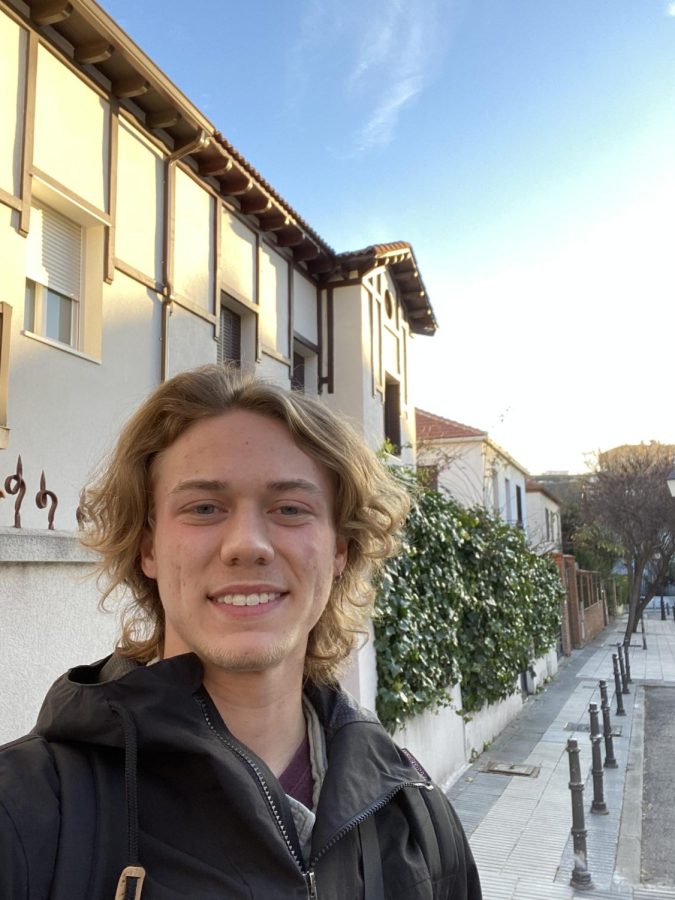Chase-ing Spain: Starting the journey
Chase Hollenkamp on the streets of Madrid, Spain.
January 19, 2022
Entering the romantic city of Madrid, surrounded by the energy of Madrileños* and the people still celebrating Christmas is something magical. In every street, there are thousands of people eating tapas*, having a tinto de verano* and shopping for post Christmas discounts.
Having the opportunity to study in Madrid has been a dream of mine for a long time, and the fact I am actually here fulfilling this dream is still unreal to me. Having already traveled to Barcelona, it is very nostalgic to be back on the Iberian Peninsula. What better way to describe my love for the country and all it has to offer than in a travel column?
Spain is a country situated on the western side of Europe, bordering Portugal, France, Andorra and even the African country of Morocco. Madrid, the capital city of Spain, is situated in the heart of the country, only a few hours by train to many of Spain’s other wonderful cities. It is known for its rich gastronomy, historical background and rich nightlife as well as being home to Spanish royalty.
I arrived in the city on Jan. 4 and quickly made my way by metro to the city center (only getting lost once), where I found The Hat Hostel, my home for the next four days while I waited to move in with my host family. Here I met people of all different nationalities traveling temporarily to Madrid during the holidays. Some were using Madrid as just a pitstop to a further destination, others were stopping by while they were working their way along the Camino Santiago* and a few were taking the weekend to enjoy the city.
No matter the reason for staying in Madrid, the city is without a doubt full of life during the day and absolutely buzzing throughout the night. There are countless restaurants, bars, discotecas, cafés and other points of gathering that energize all of the people they attract.
Historically, the city is rich with monuments and buildings dating back to Moorish rule before the 1400s. Apart from having a built-in history, Madrid also contains world-famous museums, including the Museo Nacional del Prado. There are palaces, parks, century-old restaurants and countless castles scattered throughout the countryside.
Recently, I have been growing accustomed to life in Madrid, enjoying time with my host family during dinner and adapting to my new school schedule. My host parents are both true Madrileños having lived here for over 35 years with no plans of leaving. They have served me typical Spanish meals like tortilla española*, croquetas* and even some locally hunted deer known as Corzo*.
My host father, Carlos, told me, “Lo más importante de toda la vida en Madrid es que la vida está en la calle.” In translation this means, “The most important part of life in Madrid is that life is in the street.” This is a fundamental idea in Spanish culture. The people live life on the streets, whether that be by going to a café to read and write literature, walking to work or school or going to the bars to socialize and have a bite to eat. One must remember the Spanish cannot truly live without this type of life centered in the European streets of Spain.
This first month, I will be exploring the distinct neighborhoods of Madrid and what they have to offer, but the rest of the semester, I will be writing about the different things I encounter in Madrid as well as the other cities and countries I have the opportunity to visit while on the European continent.
Madrileño = Citizen of Madrid
Tapas = small dishes of food eaten throughout the day
Tinto de verano = Red wine with sparkling water and ice
Camino Santiago = religious pilgrimage through the northern part of Spain
Tortilla española = Omelet made with potatoes and onion
Croquetas = Fried balls made with bechamel and meat
Corzo = Roe deer
About the Writer: Chase Hollenkamp is a sophomore at the University of Southern Indiana. He is majoring in Global Studies, Spanish and Economics and is minoring in Political Science. He is studying abroad as a USI student in Madrid, Spain for Spring 2022.








